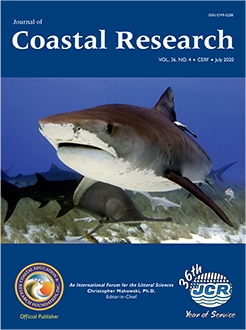Psuty, N.P.; Ames, K.; Liu, G., and Habeck, A., 2020. Interactive geomorphological resilience of sediment pathways and coastal features, post-Hurricane Sandy, Fort Tilden, New York. Journal of Coastal Research, 36(4), 694–708. Coconut Creek (Florida), ISSN 0749-0208.
Geomorphological resilience is an essential concept in dynamic coastal systems, incorporating the recovery and regeneration of the dune/beach system and the interaction between these systems, anthropogenic forces, and ecological factors. Recovery of the coastal geomorphological system at the Fort Tilden site after Hurricane Sandy was influenced by the wooden bulkhead and the variety of groins interacting with the sediment budget. Monitoring of the recovery revealed that the alongshore coastal dune/beach system response (one-dimensional, two-dimensional, and three-dimensional metrics) was strongly related to the 11 groin sectors and that the total volume losses increased downdrift. Hurricane Sandy resulted in a general inland displacement of the dune feature along the entire site, mean of –32 m, and a landward displacement of the shoreline, mean of –3 m. There was a volumetric loss of 81,000 m3; 29,000 m3 of this was from the dune feature. Post-Sandy to Fall 2018, the dune was displaced 2 m seaward and had a volumetric gain of 10,580 m3. Comparison of the dune displacement and sediment budget metric indicated that through the six-year recovery period, the dune feature was accumulating sediment but that it was not shifting seaward to its former position despite updrift beach nourishment totaling ∼3,180,000 m3 in the period 2010–18. The inland displacement and retention of the beach-dune system under a negative sediment budget is consistent with geomorphological theory, indicating a geomorphological resilience to rebuild while shifting inland. Accordingly, the former position of Shore Road along Fort Tilden is deemed unsuitable for reconstruction in place because of increased exposure in the Post-Sandy environment.





